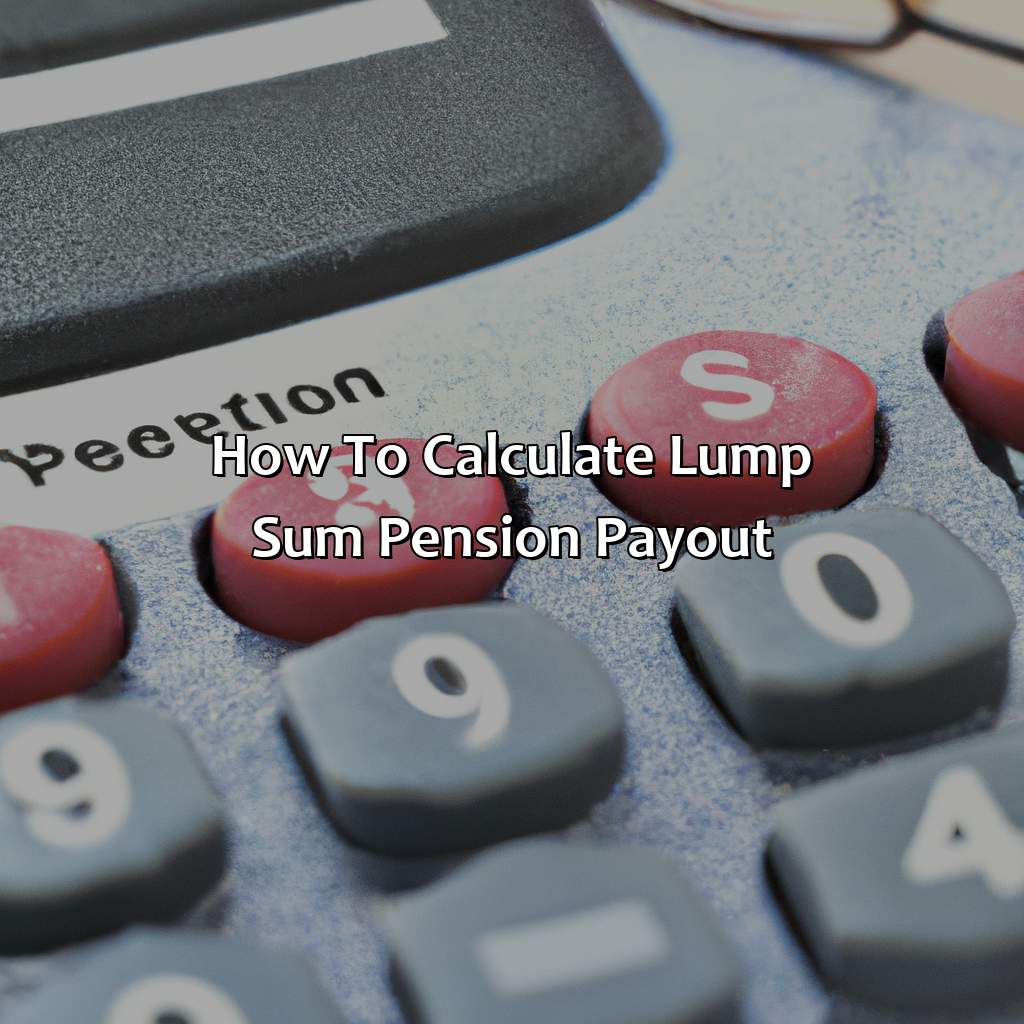How To Calculate Lump Sum Pension Payout?
Key Takeaway:
- Understanding Lump Sum Pension Payout: A lump sum pension payout is a payment made to the retiree all at once rather than in the form of monthly payments, and it is calculated based on various factors such as age, pension plan type, and years of service.
- Factors to Consider Before Calculating Lump Sum Pension: It is essential to consider factors such as the age factor, pension plan type, and years of service before calculating a lump sum pension payout, as they may affect the amount of payout received.
- Steps to Calculate Lump Sum Pension Payout: The process of calculating a lump sum pension payout involves determining pension benefit, discounting lump sum payment, calculating commuted value, calculating income tax, and calculating net cash value.
Do you want to know how to calculate the lump sum amount you can get from your pension plan? This article explains the important steps to accurately calculate the lump sum payout you can receive. Find out more and make sure you get the right lump sum amount for your retirement.
Understanding Lump Sum Pension Payout
Lump sum pension payout refers to when a retiree receives their pension in a one-time payment instead of periodic installments. To understand how to calculate this payout, one needs to consider factors such as the pension plan’s terms, the retiree’s age and life expectancy, and the interest rates. By determining the present value of the future pension payments, one can estimate the lump sum payout. It is important to consult a financial advisor to ensure that the calculation is accurate and meets one’s retirement goals.
When contemplating a lump sum pension payout, it is crucial to consider the potential risks and benefits. The main advantage of a lump sum is the flexibility it provides in managing retirement finances. However, it comes with the risk of outliving the funds and being left without enough retirement savings. It is also important to understand the tax implications of receiving a lump sum payout and how to value a pension in order to know how it may affect one’s retirement income.
While calculating a lump sum pension payout can be complex, understanding the process is crucial to making informed retirement decisions. Consultation with a financial advisor can provide valuable insight and guidance for determining the optimal payout option. Don’t wait until it’s too late to plan for retirement- take proactive steps to secure your financial future.

Image credits: retiregenz.com by David Arnold
Factors to Consider Before Calculating Lump Sum Pension
Want to get the highest possible lump sum pension payout? Consider three factors: age, type of pension plan, and years of service. These three sub-sections help you calculate your payout accurately. Be aware – they can impact the final amount you receive!

Image credits: retiregenz.com by David Arnold
Age Factor
When it comes to calculating your lump sum pension payout, the age factor plays a crucial role in determining the final amount. As you grow older, your pension payments may increase. However, this also means that your lump sum payout will be lower. Therefore, it’s important to consider your age and how it may affect your final payout.
Additionally, factors such as your retirement age and life expectancy can also impact your lump sum pension amount. Those who retire earlier may receive a higher lump sum payout due to the reduced lifespan of their pension payments. On the other hand, if you expect to live longer, it may be more beneficial to take smaller pension payments for a longer period.
It’s worth noting that some pensions offer different lump sum options based on age or retirement date. Be sure to carefully evaluate these choices and consult with a financial advisor before making any decisions. If you are wondering how long after divorce can you claim pension, it would be best to consult with a professional.
A friend of mine recently retired at 55 and faced the decision of whether to take a higher monthly pension payment or a lower lump sum payout. Ultimately, she opted for the lower payout as she felt confident in her ability to manage her finances and wanted more flexibility with her retirement funds. Each person’s situation is unique, so it’s important to take all factors into account before calculating your own pension expense.
Pension plan types are like ice cream flavors – some are vanilla, some are chocolate, but they all still make you feel old.
Pension Plan Type
In considering the type of pension plan, it is important to assess the various options available. This includes defined benefit, defined contribution, cash balance and hybrid plans. The type of plan selected may vary depending on factors such as age and financial objectives.
| Pension Plan Type | Description |
|---|---|
| Defined Benefit | Employer guarantees a fixed benefit payout based on salary history and length of service |
| Defined Contribution | Contributions are deposited into individual accounts with benefits determined by investment returns |
| Cash Balance | Employer contributes to a hypothetical account using a formula which determines the payouts |
| Hybrid Plans | Combination of different types of pension plans |
While each plan has its unique features and advantages, understanding how your payout will be calculated with each option can help you make an informed decision. Considerations such as vesting schedules, contribution rates and projected investment returns can have significant impacts on lump sum calculations.
A close friend once faced difficulty in determining whether to take a lump sum payout or monthly payments from his pension plan. After evaluating his current financial situation, he opted for the lump sum option since he wanted more control over his retirement savings.
Years of service only matter if you were there long enough to accumulate an actual sum worth retiring on.
Years of Service
One crucial criterion to consider before calculating a lump sum pension payout is the number of years one has served. The length of service can directly impact how much money an individual will receive as part of their retirement package.
Employers and pension plans commonly use the term ‘years of dedication’ to describe the duration of an employee’s service. This duration can range from a few years to several decades and may also vary between different jobs or careers an individual may have pursued throughout their life. For those wondering how to calculate pension asset liability, there are various methods that take into account factors such as salary, age, and length of service.
Furthermore, years of service can be essential in determining whether an employee is eligible for additional benefits such as health insurance or life insurance post-retirement, based on the length of time that they worked for a particular company or establishment. If you’re going through a divorce, you may be wondering how much of your pension your ex-wife can claim.
History shows us that employers used to provide pensions solely to reward employees after many years or even decades of hard work and loyalty towards the company. Over time, these benefits became more standardized and streamlined through unionization efforts which led to further legal recognition and protection for pension plan holders. If you’re wondering how to calculate pension, it’s important to understand the factors that go into it.
Get ready to crunch some numbers and make your retirement dreams come true with these simple steps to calculate your lump sum pension payout.
Steps to Calculate Lump Sum Pension Payout
For easy lump sum pension payout calculation, you’ll need to take certain steps. Firstly, find your pension benefit amount. Secondly, use a suitable interest rate to discount a lump sum payment. Thirdly, compute the commuted value of your pension. Lastly, calculate income tax and net cash value. Each of these sub-sections will give you a way to calculate your lump sum pension payout quickly.

Image credits: retiregenz.com by Joel Duncun
Determine Pension Benefit
To determine the amount of pension benefit you’re entitled to, several factors come into play. The computation considers your work history and other details such as retirement age, earnings history, length of service, investment returns, cost-of-living adjustments, and other actuarial assumptions. Follow the steps below to determine your pension benefits:
- Understand the plan requirements and eligibility criteria
- Review recent account statements or call the pension administrator
- Familiarize yourself with different payout options, like lump-sum distributions or annuities
- Determine how much you would need monthly in retirement by making a budget
- Perform calculations based on your anticipated lifespan and forecasted investment performance.
It’s worth keeping in mind that pensions are typically designed to provide a specific benefit for life and include guaranteed income streams for spouses. Beyond considering these factors mentioned earlier, determining the right benefit requires weighing inflation risk, investment growth expectations, taxation liabilities, among others. According to a Vanguard study in 2021, best practices suggest using a withdrawal rate of 3 4% per year to ensure enough cash flow while saving enough for long-term needs. Saving money on your lump sum payout is great, unless it’s because you passed away before retirement.
Discount Lump Sum Payment
A Reduced Lump Sum Payment, also known as a Discount Lump Sum Payment, is a retirement benefit option that allows pension plan members to receive a reduced payment in exchange for receiving the full benefits immediately.
- It is typically lower than the actuarial present value and future annual payments.
- The discount rate used varies from plan to plan based on interest rates and market trends.
- An actuarial calculation determines the amount of the reduction during valuation.
- The lump sum amount is calculated after determining your average salary, years of service and age at retirement.
- You can choose either annuity payments or lump sum payouts depending on your financial goals.
When you opt for a discount lump sum payment, you lose out on the benefits of guaranteed income and regular payments. Also, while it may be beneficial in some cases, this option may not be ideal for everyone. You should discuss your options with a professional or use an online calculator to determine whether this is the right choice for you.
Pro Tip: Before deciding on a pension payout option, review your financial goals with an advisor who specializes in retirement planning.
If you are going through a divorce, it may affect your pension. It is important to understand what happens to your pension when you divorce and how to calculate a lump sum payout if necessary. Make sure to consult with a qualified professional for specific guidance on your individual situation.
Calculating commuted value is like trying to solve a Rubik’s Cube, but with the added pressure of your retirement on the line.
Calculate Commuted Value
Calculating the lump sum pension payout involves determining the commuted value of the pension plan. This is a crucial step that determines how much money you will receive at once rather than in regular payments.
Here is a 5-step guide to calculate the commuted value of the pension:
- Identify the pension plan type and its vested benefits.
- Determine the date when you want to access your funds.
- Consider demographic factors such as age, gender, marital status, and life expectancy.
- Calculate the discount rates based on market conditions and long-term bond yields.
- Use an online calculator or specialized software to determine your commuted value.
It is essential to note that factors such as inflation and emotional considerations may also play a role in deciding whether to take a lump-sum payout or accept periodic payments. To know more about what is commuted value of pension, this article can be helpful.
The method for calculating lump sum pensions has evolved over time with regulations on defined benefit pensions extended and increasing complexities arising from changes in demographics.
Ready for some math? Buckle up, because calculating income tax is about to be more complicated than a calculus exam.
Calculate Income Tax
When it comes to figuring out your income tax, there are specific steps you need to follow. The following guide will help you understand how to calculate your income tax without any issues.
- Determine your taxable income – this includes any income from employment, investments, rental properties, and other sources.
- Deduct eligible expenses – these can include certain deductions for medical expenses, charitable donations, and business expenses.
- Calculate your gross tax owed – this is determined by applying the appropriate tax rate to your taxable income after deductions.
- Determine credits and subsidies – some government programs offer tax credits or subsidies that can be used to offset your gross tax amount.
- Calculate net federal tax owing – this is done by subtracting any applicable credits from your gross federal tax payment.
- Repeat the process on a provincial level – many provinces also have their own tax rates and formulas that need to be applied.
It’s important to note that some aspects of the calculation may not be apparent at first glance and may require professional assistance in order to fully comprehend the calculations.
Pro Tip: It’s always helpful to keep track of your expenses throughout the year so that you can properly deduct them come tax season.
Calculate Net Cash Value
To determine the amount of cash value received from a lump sum pension payout, there are a few steps that need to be followed. The process involves calculating the present value of future payments and taking into account various factors such as interest rates, life expectancy, and inflation rates.
- Gather all relevant information regarding the pension plan from the employer.
- Determine the age at which you plan to retire and begin receiving payments.
- Calculate the expected monthly pension payment based on the retirement age and the amount accrued in the plan.
- Consider factors such as life expectancy and inflation to calculate how much these payments will be worth in today’s dollars.
- Use an online calculator or consult with a financial advisor to calculate the present value of future payments.
- Subtract any taxes or fees associated with the lump sum payout to arrive at your net cash value.
It is important to note that these calculations may vary depending on individual circumstances, including marital status and other sources of income. It is recommended to seek advice from a qualified financial professional for personalized guidance.
In addition, some employers may offer different options for pension payouts, such as annuities or partial lump sum payouts. It is essential to carefully consider all available options before making a decision on how to keep your pension in a divorce.
Don’t miss out on maximizing your retirement savings. Consult with a financial advisor and learn about all available pension payout options to make an informed decision about your future finances. If you’re going through a divorce, it’s important to know how to calculate pension value for divorce in order to protect your financial interests and plan for your future.
Five Facts About How To Calculate Lump Sum Pension Payout:
A lump sum pension payout is a single, up-front payment instead of a monthly pension payment. (Source: The Balance)
To calculate a lump sum pension payout, you need to know your monthly pension benefit, the interest rate you can earn, and your life expectancy. (Source: SmartAsset)
Some pension plans offer options to take a reduced lump sum payment and a reduced monthly pension, or a larger monthly pension with no lump sum payment. (Source: Investopedia)
You may be subject to taxes and penalties when taking a lump sum pension payout if you’re not yet 59 and a half years old. (Source: Forbes)
It’s important to consider your overall financial situation and consult a financial advisor before making a decision about taking a lump sum pension payout. (Source: The Motley Fool)
FAQs about How To Calculate Lump Sum Pension Payout?
How do I calculate my lump sum pension payout?
To calculate your lump sum pension payout, you will need to know your current age, retirement age, years of service, and pension plan formula. Once you have this information, you can use an online pension calculator or work with a financial professional to determine your lump sum payout.
What is the pension plan formula?
The pension plan formula is the formula used to calculate your monthly pension benefit. It takes into account your years of service, your highest average salary, and a percentage factor. This percentage factor varies based on the specific pension plan you are enrolled in.
Can I receive a lump sum payout instead of monthly pension payments?
Yes, many pension plans offer the option to receive a lump sum payout instead of monthly pension payments. However, it is important to weigh the pros and cons of both options before making a decision. A lump sum payout may provide more flexibility, but it also comes with the risks of managing your own investments and potential volatility in the market.
What factors can affect my lump sum pension payout?
Several factors can affect your lump sum pension payout, including your age, retirement age, years of service, and the pension plan formula. In addition, fluctuations in interest rates and market conditions can also impact your lump sum payout.
How are taxes calculated on a lump sum pension payout?
Taxes on a lump sum pension payout are calculated based on your individual tax bracket. The lump sum payout is taxed as ordinary income, which means the amount you owe in taxes will depend on how much you receive and your overall income for the year.
What should I consider before taking a lump sum pension payout?
Before taking a lump sum pension payout, it is important to consider your financial goals, risk tolerance, and overall financial situation. You should also assess the stability of your pension plan and any potential risks associated with managing your own investments. Working with a financial professional can help you make an informed decision that aligns with your long-term financial goals.
 Checkout this IRS Loophole
Checkout this IRS Loophole 
